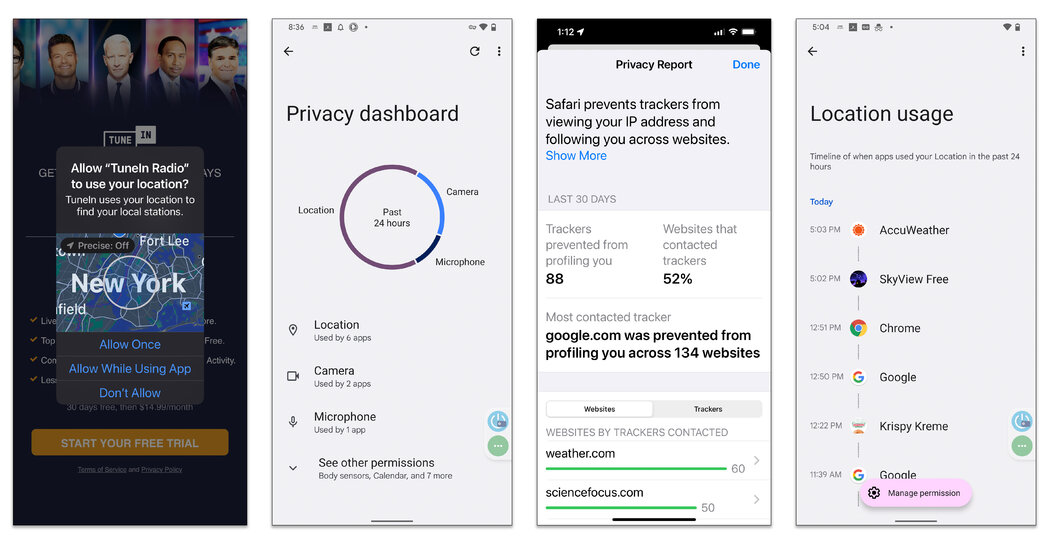
Concerned about how your data is being used by apps and websites? Apple’s iOS 15 and Google’s Android 12 operating systems beefed up their privacy controls this year to give you more warnings — and options — when a site or service wants to use personal information like location or browser clicks. Here’s a quick guide to those settings.
System Settings
In iOS or Android, open the Settings app by tap (or by voice) and select Privacy. You’ll find several screens, menus and switches for restricting access to the phone’s hardware (like the microphone) and software (like your contacts list) on an app-by-app basis. Android 12 includes a privacy dashboard to show what apps have been up to, as well as shortcuts to managing the information that Google collects and stores in one’s Google Account.
If you are curious, Apple and Google have posted statements about how they use your data. Keep in mind that blocking web trackers and location information can make your free apps work differently, and many news and cultural sites use tracking software. But if you want more control over your information, here are some specific categories to hit.
On an iOS 15 device, open the Settings app and go to Privacy, then to Location Services and then System Services. Here, you can disable or enable location services and control which third-party apps (including Google’s software) can use your coordinates — or when they have permission to use that information. Scroll all the way down the list and select System Services to see how the iPhone uses your location, like collecting your “significant locations” such as your home address; you can turn this off or wipe the history if you find it invasive.
On a phone running Android 12, open the Settings app and tap Location to open the controls and to see which apps have permission to use your location. Tap Location Services to get to more settings; you can also manage the Location History setting that records your wanderings. (Google’s business model includes serving up customized ads and services based on your personal information, so your user experience may be affected.)
Apps and Ads
Apple’s App Tracking Transparency feature warns you when an app wants to monitor your online activity, typically for the purpose of targeted advertising. In iOS 15 Settings, tap Privacy and then Tracking to get to the controls. (While Apple’s own advertising platform claims not to share personally identifiable data with others, you can turn off those ads in the Apple Advertising area of the Privacy settings.)
In Android 12, open the Settings and select Privacy to get to a slew of controls, including the Ads option for avoiding targeted ads by deleting one’s Advertising ID. And this month, Google announced that Android will automatically turn off permissions for apps you haven’t used in awhile.
Web
Browsers have been used for decades to track you through cookies and other code that observes your activity for use in marketing and advertising. (Safari’s Private Browsing and Chrome’s Incognito mode keep a surfing session from being stored, but these aren’t much help against browser trackers.)
Apple’s Safari browser includes tools to block tracking; go to Settings, then Safari, and scroll down to the Privacy & Security to make adjustments. The settings for Google’s Chrome browser have a Privacy and Security section, too, where you can request that sites do not track you, although some do anyway.
Switching to a privacy-focused browser app like Brave or DuckDuckGo is another way to ditch many web trackers. DuckDuckGo recently announced its own App Tracking Protection Tool and an email protection feature for the Android edition of its DuckDuckGo Privacy Browser; these are in a public testing phase.
In some messages, advertisers may use a “tracking pixel” — a tiny hidden image that reports back to the sender when you open the message (among other things). Apple’s iOS 15 includes its own tool to help block mail trackers. To enable it, go to Settings, then to Mail, select Privacy Protection and tap on Protect Mail Activity.
In the Gmail app for Android or iOS, you can stop images from automatically loading and squealing on your activity. Just tap open the Menu icon in the top-left corner, choose Settings, then your account name, and in the Images area choose the “Ask before displaying external images …” option. And you can always block or unsubscribe from unwanted mailing-list messages.







